Welcome to my kitchen's pride and joy – my Filipino Beef Adobo recipe! This mouthwatering dish features tender beef short ribs slowly braised in a savory-tangy sauce of soy sauce, vinegar, and aromatics that will have everyone asking for seconds.
I've been perfecting this recipe for years, and trust me, the rich flavors and fall-off-the-bone meat are absolutely worth the wait! The best part? Most of the cooking time is hands-off, letting your oven do the work while the incredible aroma fills your home.
This authentic Filipino classic might just become your family's new favorite comfort food – it certainly is in my household.
What is Filipino Beef Adobo?
Filipino Beef Adobo is a classic dish featuring beef braised in a savory mixture of soy sauce, vinegar, garlic, and spices. While many associate adobo primarily with chicken, this cooking method works beautifully with various proteins, with beef short ribs being particularly excellent for creating rich, flavorful results.
The key to perfect beef adobo lies in patience – allowing the meat to slowly braise until fork-tender while absorbing the signature adobo flavors. This cooking technique transforms tough cuts like short ribs into melt-in-your-mouth meat with an intensely flavorful sauce.
Jump to:
Ingredients
I've carefully selected these ingredients to create the perfect balance of flavors in this adobo. The bone-in short ribs provide rich, meaty flavor and become incredibly tender during braising.
Lauriat soy sauce and Datu Puti vinegar are traditional Filipino brands that give this dish its authentic taste, while the generous amount of garlic and onion creates a flavorful aromatic base.
The bay leaves and peppercorns add subtle complexity, and the brown sugar balances the saltiness and tanginess for that perfect adobo flavor profile.

- 3 pounds bone-in beef short ribs
- Kosher salt for seasoning
- Freshly cracked black pepper for seasoning
- 2 tablespoons avocado oil
- 1 medium yellow onion, halved and sliced into ⅛-inch thick slices
- ¼ cup garlic, minced (about 8-10 cloves)
- ⅓ cup soy sauce (preferably Lauriat brand)
- 2½ teaspoons packed brown sugar
- ¼ teaspoon black peppercorns
- 3 large bay leaves
- ½ cup vinegar (preferably Datu Puti cane vinegar)
- 1 cup water
Equipment
- 3.5-quart braiser or heavy-bottom Dutch oven with lid
- Sharp knife and cutting board
- Measuring cups and spoons
- Tongs for flipping meat
- Paper towels
- Spoon for skimming fat
- Oven mitts
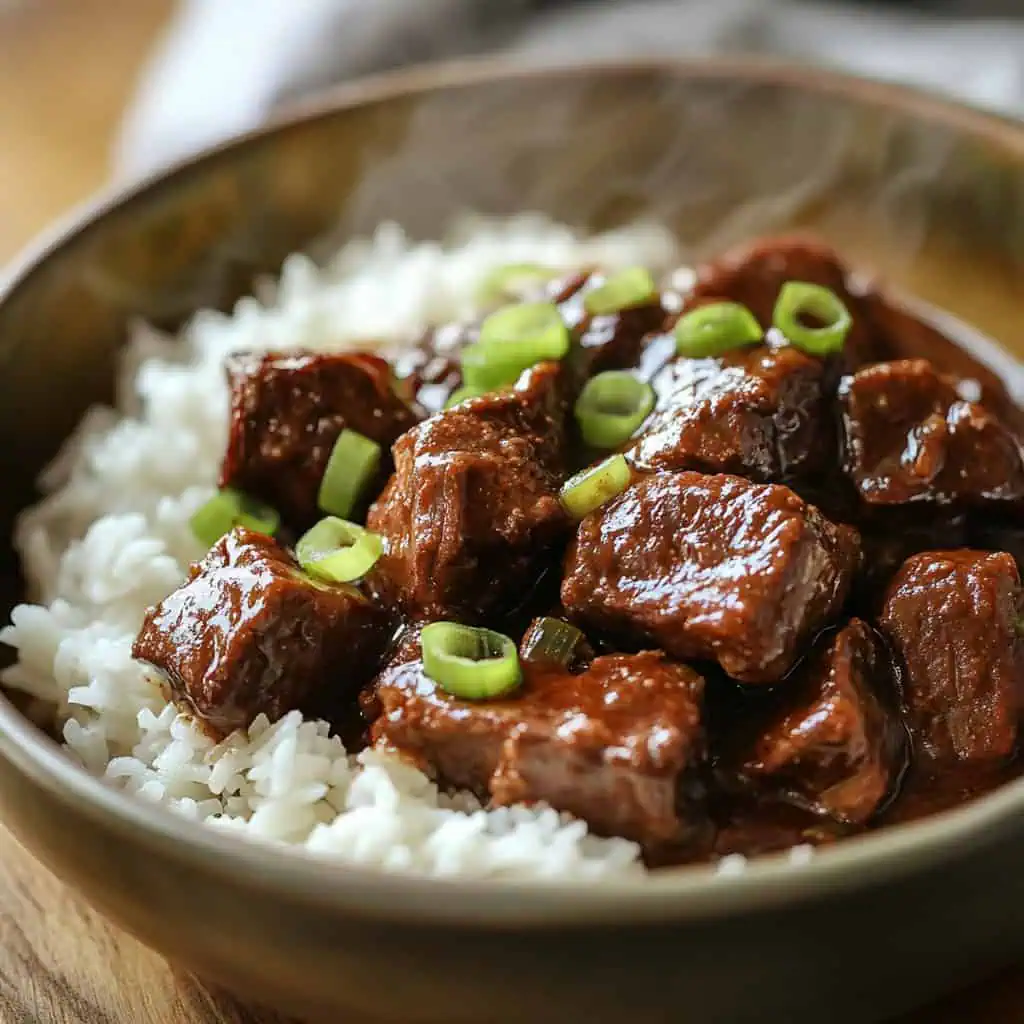
How To Make
- Season short ribs: Remove short ribs from the refrigerator 30 minutes before cooking to bring to room temperature. Pat dry with paper towels to remove excess moisture (this ensures proper browning). Season all sides generously with kosher salt and freshly cracked black pepper.
- Preheat oven to 300°F.
- Sear and brown: Heat avocado oil in your braiser or heavy-bottom pot over medium-high heat. Working in batches if necessary to avoid crowding, add short ribs and brown thoroughly on all sides, about 10-15 minutes total. This step is crucial for developing flavor. Remove browned short ribs and set aside on a plate. Discard all but 2½ tablespoons of oil from the pot.
- Sauté aromatics: Reduce heat to medium. Add minced garlic and sliced onion to the pot and sauté until fragrant and softened, about 4 minutes.
- Add base ingredients: Add soy sauce, peppercorns, brown sugar, and bay leaves to the pot. Stir until well combined and sugar has dissolved.
- Add vinegar properly: Pour in the vinegar but DO NOT STIR. Cover the pot with its lid immediately. This traditional technique prevents the strong vinegar aroma from overwhelming your kitchen. Wait until the contents reach a boil before stirring.
- Begin braising: Once the liquid reaches a boil, return the short ribs to the pot and add water. Bring the mixture back to a boil, then turn off the heat. Cover with the lid and transfer to the preheated oven.
- Slow cook: Braise in the oven for 2-2½ hours, or until the meat is fork-tender, flipping the short ribs once at the halfway mark to ensure even cooking.
- Finish and serve: Remove from oven. Carefully skim unwanted oil from the top of the sauce and discard any loose bones. Serve hot over steamed jasmine rice.

Tips from Lola's Kitchen
- The vinegar technique: Never stir the vinegar immediately after adding it to the pot. Following the traditional method of covering and allowing it to come to a boil first helps cook off the harshness while preserving its tangy flavor.
- Choose the right short ribs: Look for well-marbled pieces with good meat-to-bone ratio. The fat will render during cooking, creating incredible flavor.
- Don't rush the browning: Take your time developing a deep brown crust on the meat. This step builds the foundation of flavor for the entire dish.
- Taste before serving: The saltiness of different soy sauce brands can vary. Taste your adobo before serving and adjust seasonings if needed.
- Let it rest: If time allows, make this dish a day ahead. Like many braised dishes, Filipino Beef Adobo tastes even better the next day after the flavors have had time to develop.
Substitutions
- Soy sauce: If you can't find Lauriat, use a good quality, less-sodium soy sauce.
- Vinegar: While Datu Puti cane vinegar gives the most authentic flavor, apple cider vinegar makes an excellent substitute. In a pinch, white vinegar will also work, though the flavor profile will be slightly different.
- Beef cuts: While short ribs provide the best texture and flavor, you can substitute beef chuck roast cut into 2-inch cubes, increasing cooking time by about 30 minutes.
- Oil: Any high smoke point oil like vegetable or canola can replace avocado oil.
- Sugar: Palm sugar or white sugar can substitute for brown sugar, though brown sugar adds a subtle molasses note.
Troubleshooting
- Meat too tough? Your short ribs likely need more cooking time. Return to the oven and check every 20-30 minutes until fork-tender.
- Sauce too salty? Add ¼ cup water and a teaspoon of brown sugar to balance the saltiness. For extreme cases, a peeled, quartered potato simmered in the sauce for 10 minutes can absorb excess salt (remove before serving).
- Sauce too tangy? Add an additional ½-1 teaspoon of brown sugar to balance the acidity.
- Sauce too thin? Remove the meat, then simmer the sauce uncovered on the stovetop for 10-15 minutes to reduce and thicken.
- Sauce too thick? Add water, 2 tablespoons at a time, until desired consistency is reached.
Storage & Reheating
- Refrigeration: Allow leftovers to cool completely before transferring to an airtight container. Refrigerate for up to 8 days. The flavor actually improves after a day or two!
- Freezing: Transfer cooled adobo to freezer-safe containers or heavy-duty freezer bags. Freeze for up to 3 months. Thaw overnight in the refrigerator before reheating.
- Reheating: For best results, reheat gently on the stovetop over medium-low heat until warmed through. Add a splash of water if the sauce has thickened too much. Alternatively, reheat covered in a 325°F oven for about 20 minutes or until heated through.
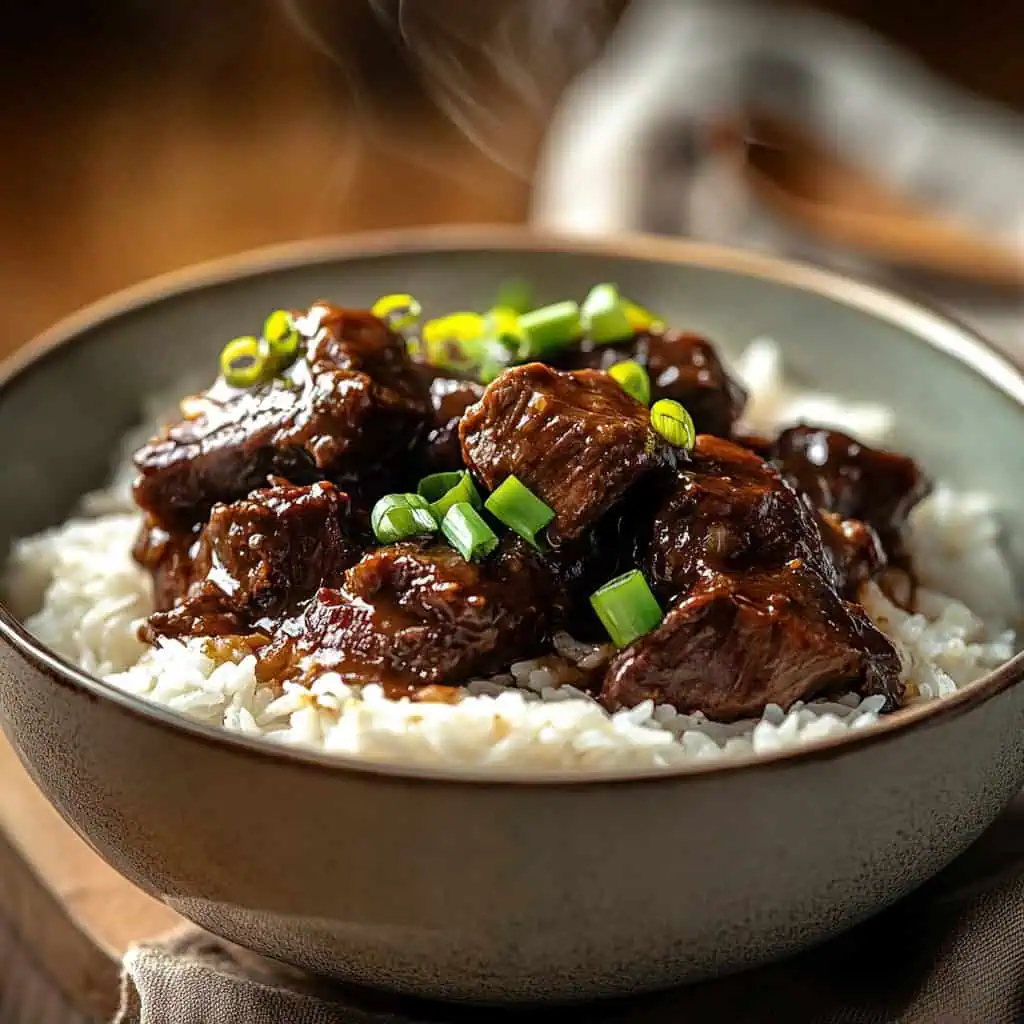
FAQ
Can I make this in a slow cooker?
Absolutely! Brown the meat and sauté aromatics as directed, then transfer everything to a slow cooker. Cook on LOW for 7-8 hours or HIGH for 4-5 hours until meat is tender.
Can I make this in an Instant Pot?
Yes! Use the sauté function to brown the meat and aromatics, then pressure cook on HIGH for 45 minutes with a 15-minute natural release.
Is this dish spicy?
No, Filipino Beef Adobo isn't spicy. It's savory, tangy, and slightly sweet with a complex flavor profile.
Why shouldn't I stir the vinegar right away?
This traditional technique allows the vinegar to cook without releasing strong vapors throughout your kitchen. It also helps mellow the sharp acidity while maintaining its essential tang.
What makes Filipino adobo different from Mexican or Spanish adobo?
Despite sharing a name, they're quite different! Filipino adobo uses soy sauce and vinegar as its base, while Mexican and Spanish versions typically use chilis, paprika, oregano, and vinegar.
What can I serve with Beef Adobo?
Traditional accompaniments include steamed jasmine rice, pickled vegetables, or a simple cucumber salad to balance the rich flavors. Creamy polenta also makes an excellent non-traditional pairing.
Related
Looking for other recipes like this? Try these:
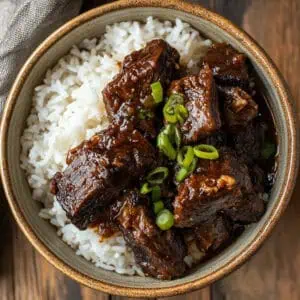
Filipino Beef Adobo Recipe
Ingredients
- 3 pounds bone-in beef short ribs
- Kosher salt for seasoning
- Freshly cracked black pepper for seasoning
- 2 tablespoons avocado oil
- 1 medium yellow onion halved and sliced into ⅛-inch thick slices
- ¼ cup garlic minced (about 8-10 cloves)
- ⅓ cup soy sauce preferably Lauriat brand
- 2½ teaspoons packed brown sugar
- ¼ teaspoon black peppercorns
- 3 large bay leaves
- ½ cup vinegar preferably Datu Puti cane vinegar
- 1 cup water
Instructions
- Season short ribs: Remove short ribs from the refrigerator 30 minutes before cooking to bring to room temperature. Pat dry with paper towels to remove excess moisture (this ensures proper browning). Season all sides generously with kosher salt and freshly cracked black pepper.
- Preheat oven to 300°F.
- Sear and brown: Heat avocado oil in your braiser or heavy-bottom pot over medium-high heat. Working in batches if necessary to avoid crowding, add short ribs and brown thoroughly on all sides, about 10-15 minutes total. This step is crucial for developing flavor. Remove browned short ribs and set aside on a plate. Discard all but 2½ tablespoons of oil from the pot.
- Sauté aromatics: Reduce heat to medium. Add minced garlic and sliced onion to the pot and sauté until fragrant and softened, about 4 minutes.
- Add base ingredients: Add soy sauce, peppercorns, brown sugar, and bay leaves to the pot. Stir until well combined and sugar has dissolved.
- Add vinegar properly: Pour in the vinegar but DO NOT STIR. Cover the pot with its lid immediately. This traditional technique prevents the strong vinegar aroma from overwhelming your kitchen. Wait until the contents reach a boil before stirring.
- Begin braising: Once the liquid reaches a boil, return the short ribs to the pot and add water. Bring the mixture back to a boil, then turn off the heat. Cover with the lid and transfer to the preheated oven.
- Slow cook: Braise in the oven for 2-2½ hours, or until the meat is fork-tender, flipping the short ribs once at the halfway mark to ensure even cooking.
- Finish and serve: Remove from oven. Carefully skim unwanted oil from the top of the sauce and discard any loose bones. Serve hot over steamed jasmine rice.
Tips from Lola's Kitchen
- The vinegar technique: Never stir the vinegar immediately after adding it to the pot. Following the traditional method of covering and allowing it to come to a boil first helps cook off the harshness while preserving its tangy flavor.
- Choose the right short ribs: Look for well-marbled pieces with good meat-to-bone ratio. The fat will render during cooking, creating incredible flavor.
- Don't rush the browning: Take your time developing a deep brown crust on the meat. This step builds the foundation of flavor for the entire dish.
- Taste before serving: The saltiness of different soy sauce brands can vary. Taste your adobo before serving and adjust seasonings if needed.
- Let it rest: If time allows, make this dish a day ahead. Like many braised dishes, Filipino Beef Adobo tastes even better the next day after the flavors have had time to develop.
The Story Behind Filipino Beef Adobo
Filipino Beef Adobo traces its roots to pre-colonial Philippines, where the cooking method was born out of necessity. Long before refrigeration, ancient Filipinos discovered that marinating meat in vinegar and salt preserved it in the tropical heat. This practical preservation technique eventually evolved into one of the Philippines' most beloved culinary treasures.
When Spanish colonizers arrived in the 16th century, they observed this cooking process and named it "adobo," from the Spanish word "adobar," meaning to marinate. Though sharing a name with Spanish and Mexican adobo dishes, Filipino adobo developed independently and distinctly. The addition of soy sauce came later with Chinese trading influence, creating the savory-tangy profile we know today.
Every Filipino family has their own version of adobo. Some regions add coconut milk for creaminess, while others incorporate sugar for sweetness or chilies for heat. This dish transcends regional and social boundaries, appearing on humble family tables and upscale restaurant menus alike. It's often called the unofficial national dish of the Philippines because of its cultural significance and widespread popularity.
What makes beef adobo special among the many adobo variations is how the long cooking process transforms tough, inexpensive cuts like short ribs into luxuriously tender meat. The collagen-rich beef breaks down during braising, creating a silky, flavorful sauce that's perfect for spooning over rice. My family's version emphasizes the perfect balance between soy sauce and vinegar, with plenty of garlic for depth.
Beef adobo actually tastes better the next day, as the flavors meld and intensify overnight. This make-ahead quality made it a practical dish for Filipino celebrations and gatherings. Today, many Filipino-American families consider adobo a taste of heritage and home, a dish that connects generations through its familiar, comforting flavors. When I make this recipe, I'm not just preparing a meal – I'm continuing a culinary tradition that spans centuries.
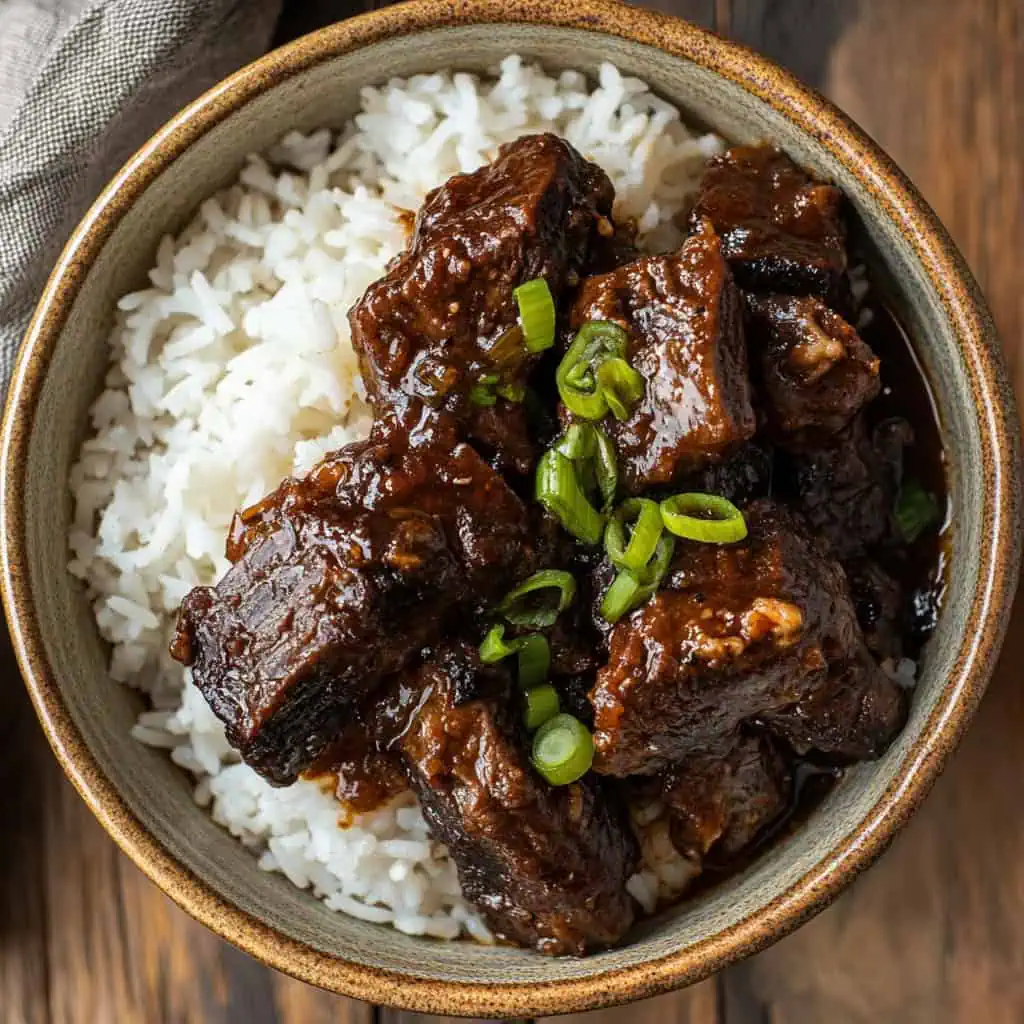






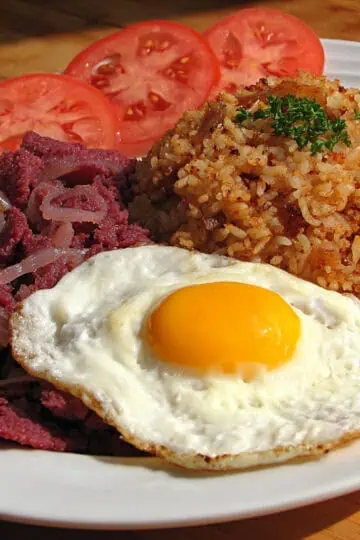


Comments
No Comments